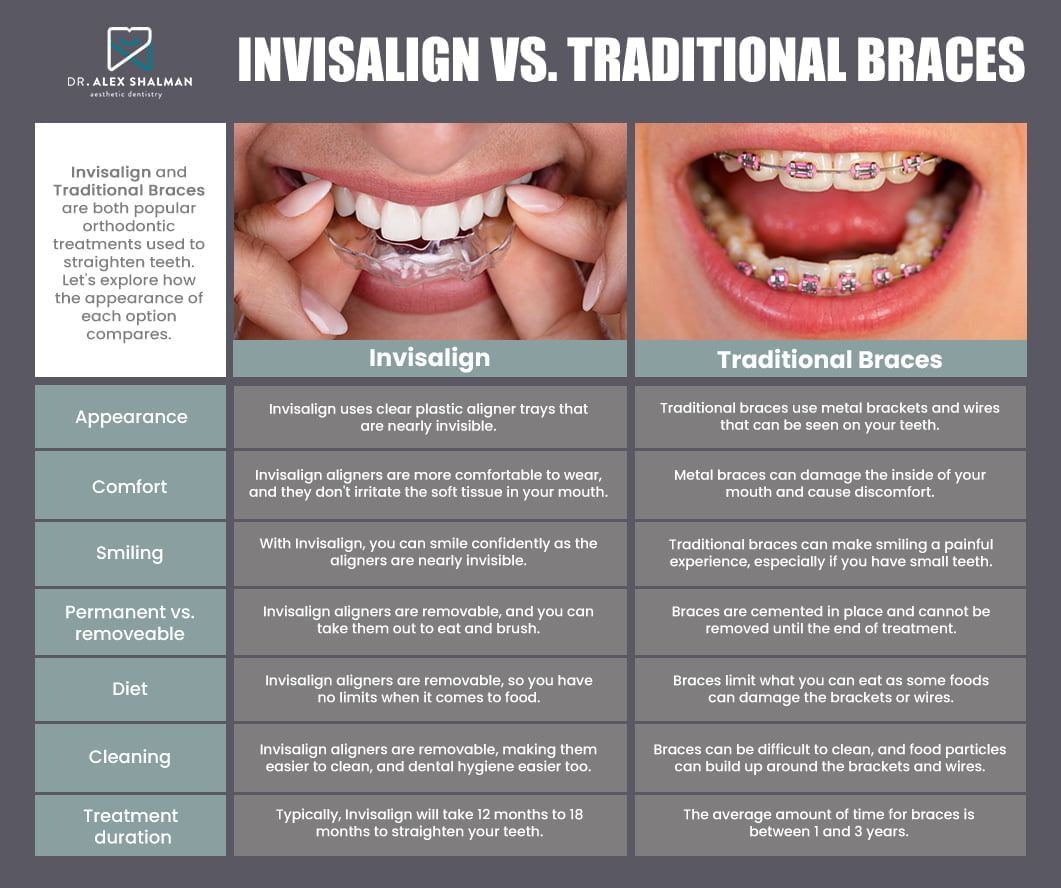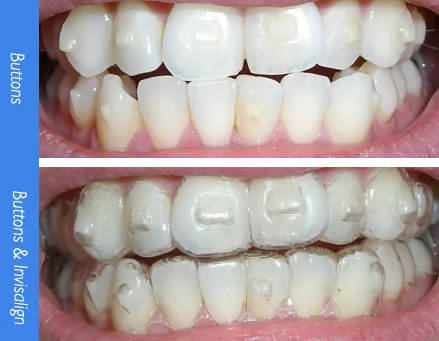Invisalign vs. Traditional Braces: Which Choice Is Right for You?
When thinking about orthodontic therapy, the choice between Invisalign and standard dental braces provides numerous important aspects that warrant careful analysis. Invisalign uses a very discreet alternative with detachable aligners, while conventional braces provide a more visible yet reliable option for severe imbalance. Each option encompasses unique benefits and disadvantages connected to aesthetics, convenience, therapy period, and cost. Comprehending these nuances is important for making a notified decision that lines up with your individual choices and way of living. The inquiry remains: which choice will best satisfy your orthodontic requirements and expectations?
Summary of Treatment Choices

In contrast, traditional braces include metal brackets and cords that are adhered to the teeth. This technique applies constant pressure gradually to achieve placement. While effective for complex orthodontic problems, traditional dental braces need normal brows through for modifications and can position challenges in preserving oral health as a result of the trouble of cleansing around braces and cables.
Both options have their advantages, and the option commonly rests on specific oral conditions, way of life preferences, and patient compliance. Ultimately, speaking with an orthodontic specialist is vital for identifying the most appropriate therapy strategy tailored to individual demands. Comprehending the nuances of each choice can dramatically influence the overall success of orthodontic therapy.
Visual Considerations
A substantial variable influencing the selection in between Invisalign and standard dental braces is the visual allure each treatment supplies. Invisalign aligners are crafted from clear plastic, making them basically unnoticeable when used. This discreet look is especially attracting adults and young adults who might really feel uncomfortable concerning their orthodontic treatment. The capability to maintain an all-natural smile throughout the alignment process can significantly enhance the client's confidence in expert and social setups.
On the other hand, conventional dental braces contain steel brackets and cords, which can be a lot more visible. While innovations in orthodontic technology have actually led to the advancement of smaller braces and colored elastics, traditional braces still keep an even more obvious profile. For some individuals, the presence of dental braces might prevent them from looking for essential therapy.
Eventually, the option between Invisalign and typical braces may rest on personal choices regarding looks. Clients that focus on discernment usually lean towards Invisalign, while those who are less worried regarding exposure might select typical dental braces. Understanding the visual ramifications of each alternative is vital for making a notified decision that straightens with one's lifestyle and preferences.
Convenience and Convenience

In terms of ease, Invisalign aligners are detachable, allowing people to appreciate their preferred foods without constraint and preserve ideal dental hygiene. Cleaning and flossing are simplified, as the aligners can be secured during these routines, whereas conventional dental braces require careful navigating around wires and braces.
In comparison, traditional braces require click over here routine adjustments, making them less practical for those with hectic routines. On the whole, the convenience and comfort of Invisalign make it an enticing choice for many individuals seeking orthodontic therapy.
Treatment Period and Efficiency
While both Invisalign and standard dental braces are reliable in remedying dental misalignments, the duration of treatment can differ dramatically between the 2 alternatives. Generally, Invisalign therapy can take anywhere from 12 to 18 months, depending on the complexity of the case. The clear aligners work by gradually moving teeth right into their preferred placements, and routine follow-ups with an orthodontist assistance make certain progress continues to be on track.
In contrast, traditional braces typically need a longer dedication, usually ranging from 18 months to 3 years. This is because of their fixed nature and the use of wires and brackets, which can be extra reliable for serious imbalances and complicated instances (Invisalign). The treatment efficiency of standard dental braces is well-documented, as they permit precise changes and better control over tooth movement
Eventually, the option in between Invisalign and typical braces may rest on both the expected treatment period and the certain oral problems available. Consulting with an orthodontist is critical, as they can provide customized referrals based on individual needs, making sure the selected approach lines up with desired timeframes and outcomes.
Price Comparison and Insurance Choices
Expense plays a substantial role in the decision-making process for people considering orthodontic therapy, whether selecting Invisalign or traditional braces. Generally, the price of Invisalign varieties from $3,000 to $8,000, while conventional dental braces typically cost between $2,000 and $6,000. Factors influencing these prices include the intricacy of the case, the duration of therapy, and geographical area.
Numerous oral insurance plans supply partial protection for orthodontic therapies, but the specifics can differ commonly. Usually, typical dental braces may be a Continued lot more often covered by insurance coverage plans contrasted to Invisalign, which some insurers categorize as a cosmetic treatment.
Furthermore, several orthodontic practices use versatile layaway plan, making both therapy options extra available. Individuals need to ask about potential financing options and discount rates for in advance payments. Examining the complete expense, consisting of insurance coverage advantages and settlement strategies, is crucial for making an educated decision that lines up with both aesthetic choices and spending plan factors to consider.

Verdict
In summary, the selection in between Invisalign and typical braces rests on several factors, consisting of aesthetic preferences, comfort, treatment period, and cost. Invisalign offers a discreet, removable option that helps with dental health and dietary flexibility, while typical dental braces might be a lot more appropriate for complicated dental issues and typically come with a lower cost factor. Inevitably, appointment with an orthodontist is necessary to analyze private situations and determine the most suitable therapy alternative for attaining optimal dental placement.
When considering orthodontic therapy, the option between Invisalign and traditional braces presents a number of important factors that merit careful examination.Comparing Invisalign and typical braces reveals distinctive therapy choices for orthodontic adjustment.While both Invisalign and conventional braces are efficient in fixing oral imbalances, the period of treatment can vary considerably between the two choices.Price plays a substantial role in the decision-making procedure for individuals thinking about orthodontic treatment, whether choosing for Invisalign or standard dental braces.In recap, the choice in between Invisalign and typical braces pivots on multiple factors, consisting of aesthetic preferences, convenience, treatment duration, and price.